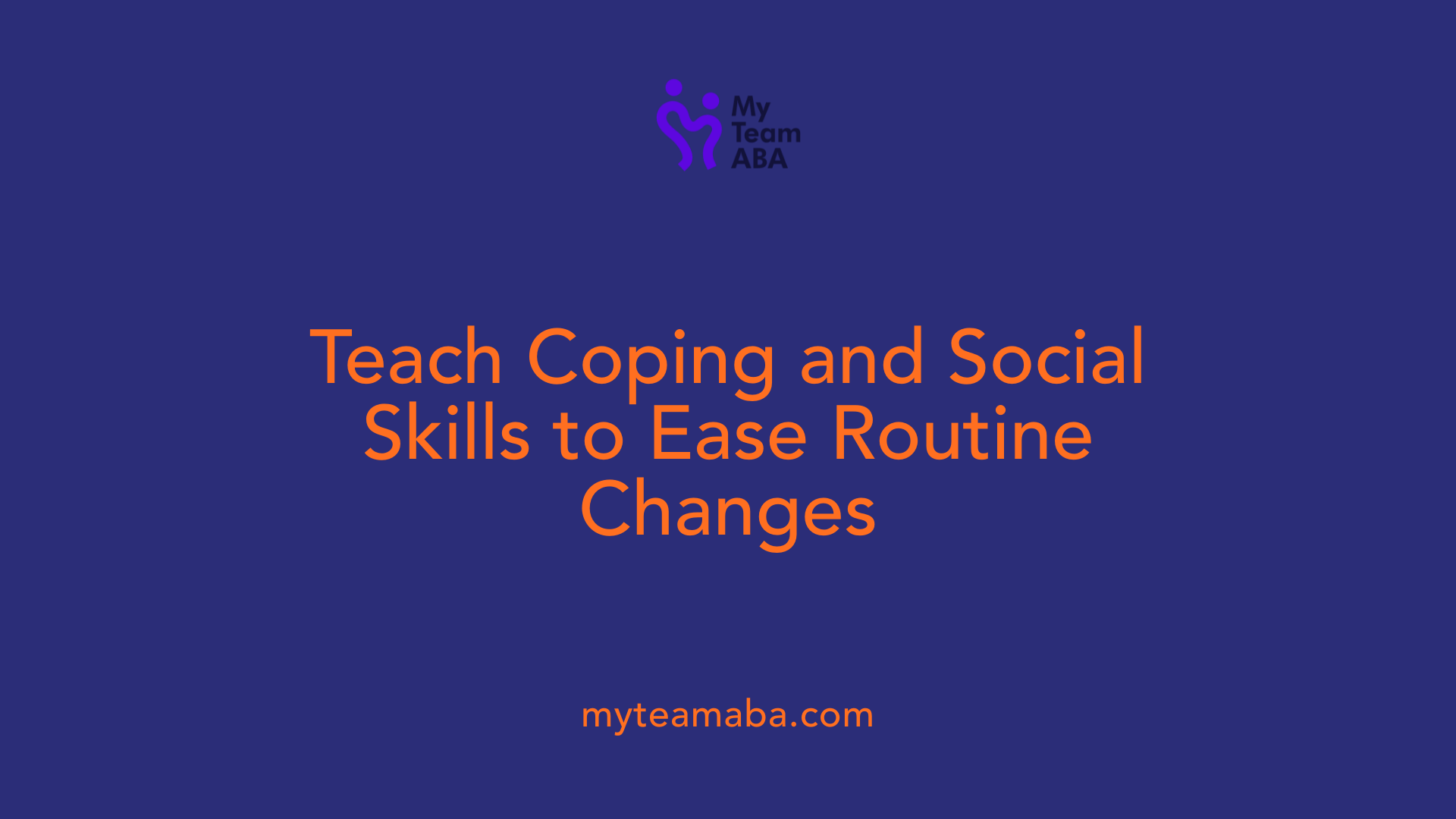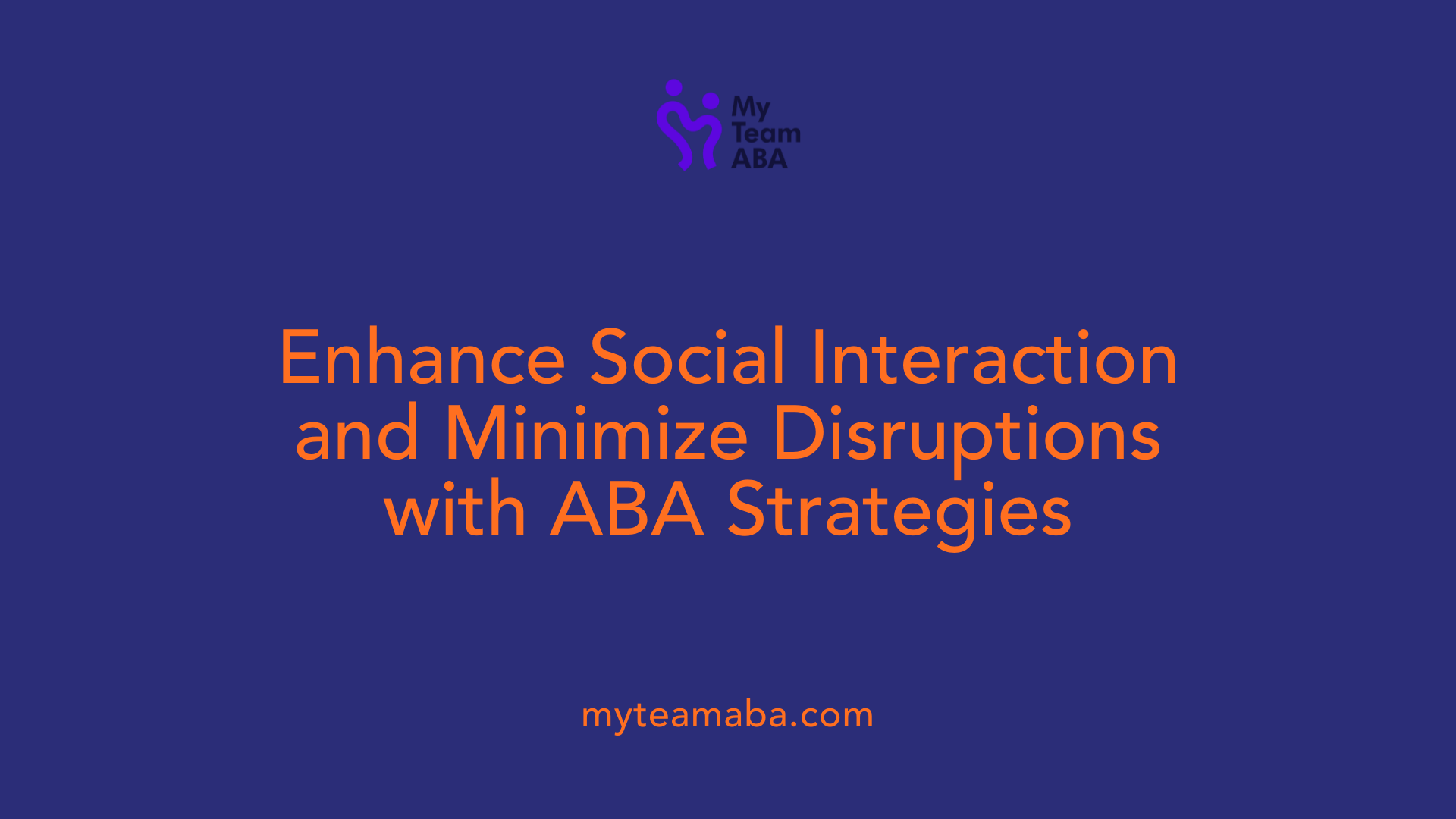How ABA Therapy Helps Children Navigate Recess and Lunchtime Challenges
July 24, 2025
Supporting Children with Autism Through School Transitions and Social Challenges

Understanding ABA Therapy in School Settings
School environments present unique social and behavioral challenges for children with autism spectrum disorder (ASD). ABA (Applied Behavior Analysis) therapy offers targeted strategies to support these children during critical times such as recess and lunchtime, fostering social interaction, promoting positive behaviors, and reducing disruptions. This article explores how ABA therapy helps children navigate these challenges, develop essential social skills, and benefit from tailored interventions in real-life school scenarios.
Addressing Behavioral Challenges During Recess and Lunch

How are behavioral challenges addressed by ABA therapy during recess and lunch periods?
Recess and lunch are social and physical moments that can sometimes trigger challenging behaviors in children with autism. To support positive experiences during these times, ABA therapy employs a multifaceted approach.
First, Behavioral challenges are often preceded by a detailed understanding through Functional Behavior Assessments (FBA). These assessments aim to uncover underlying reasons for behaviors such as tantrums, aggression, or avoidance. Knowing the cause allows therapists and educators to formulate tailored strategies.
Based on the FBA, individual Behavior Intervention Plans (BIPs) are developed. These plans outline specific interventions like positive reinforcement, prompting, and environmental modifications to promote better behavior. For example, a child might receive praise or a preferred toy when they demonstrate patience or sharing.
Prompting and prompting fading are important techniques used to teach new skills and reduce problematic behaviors. Initially, physical or visual prompts may be used to guide desired behaviors, with gradual removal to foster independence.
Environmental modifications include visual supports, such as social stories or visual schedules, to prepare children for upcoming activities. Changes in seating arrangements or providing movement breaks can also reduce triggers for disruptive behaviors.
During these periods, ABA therapists utilize both Discrete Trial Training (DTT) and Natural Environment Teaching (NET). DTT helps teach specific skills in controlled ways, while NET encourages spontaneous use of skills in natural settings, fostering better generalization.
Monitoring progress is vital. Data collection methods track behavior frequency and types, providing measurable insights. This ongoing data helps adjust interventions to improve effectiveness.
Finally, collaboration among teachers, therapists, and families ensures a consistent approach. Sharing strategies and progress updates enable everyone involved to reinforce positive behaviors both at school and at home.
Overall, ABA therapy creates a structured, supportive environment during recess and lunch, reducing triggers, teaching appropriate responses, and fostering social interaction and independence for children with autism.
Supporting Transitions and Social Activities

What strategies do ABA therapists use to support children during transitions and social activities like recess and lunch?
Children with autism often find transitions, such as moving from classroom work to recess or lunchtime, challenging due to sensory sensitivities, communication difficulties, or anxiety. ABA therapists use several effective techniques to make these changes smoother.
One of the primary tools is visual supports. Visual schedules and social stories are tailored to prepare children for upcoming activities. These visual aids display a clear sequence of steps involved in transitions, helping children anticipate what will happen next. For example, a visual schedule for a lunch break might include images of washing hands, sitting at the table, eating, and clean-up. By understanding the routine ahead of time, children experience less uncertainty and anxiety.
In addition to visuals, therapists teach coping strategies aimed at emotional regulation. These include deep breathing exercises, calming routines, and methodical self-management techniques. Such strategies give children tools to regulate their emotions when facing changes or social interactions that might otherwise overwhelm them.
Reinforcement plays a crucial role in encouraging positive social behaviors during these times. Therapists often use token systems or praise to reward behaviors like sharing, taking turns, or initiating interactions with peers. These rewards motivate children to engage more actively and appropriately in social settings.
Structured routines and task analysis break down complex activities related to social interactions into smaller, manageable steps. For example, a child might learn to ask a peer to join a game or to signal when they need a break. This step-by-step approach builds independence and confidence.
Role-playing and social skills training provide opportunities to practice social behaviors in a safe environment. Children rehearse greetings, sharing, and appropriate responses through guided activities, which enhances their real-world social interactions.
Finally, generalization strategies ensure that skills learned during therapy transfer to various environments. Therapists work on practicing these skills across different settings—such as home, school, and community—to ensure consistent application and confidence across all aspects of a child's life.
Incorporating these approaches improves not only the child's ability to handle transitions smoothly but also boosts their overall social competence, enabling more meaningful peer interactions and reduced anxiety during routine changes.
Promoting Social Skills and Reducing Disruptions

How does ABA therapy help children manage social interactions and behavioral challenges during school recess and lunchtime?
ABA therapy plays a significant role in helping children with autism navigate social situations like recess and lunchtime. These periods can be overwhelming due to sensory stimuli, unpredictable interactions, and the need for social skills that may be challenging for some children.
Therapists use a variety of individualized strategies to teach and reinforce social behaviors. For example, they can teach children how to initiate conversations, read social cues, share interests, and respect personal boundaries. These skills are broken down into small steps and practiced through role-playing, modeling, chaining, and positive reinforcement—techniques that make learning manageable and engaging.
Group and peer-mediated sessions are especially effective, offering children real-time opportunities to practice socialization. These activities help build social bonds, improve emotional understanding, and foster inclusion.
Visual supports, like social stories and visual schedules, are tools that help children understand what to expect and how to behave in different social contexts. Natural environment teaching allows children to generalize learned skills across various settings, making their social interactions more natural and effective.
The ultimate goal of ABA in these settings is to improve communication skills, emotional regulation, and social inclusion. As a result, children are better equipped to build meaningful relationships and participate actively and happily during recess and lunch, reducing disruptive behaviors.
How can strategies like social stories, visual supports, and natural environment teaching aid in this process?
These tools provide clear cues and structured guidance, which are essential for children with autism.
Social stories prepare children for social situations by explaining behaviors and expected responses in a compelling way.
Visual supports such as schedules and transition cards help children anticipate upcoming activities, reducing anxiety related to transitions.
Natural environment teaching engages children in real-life contexts, encouraging spontaneous use of social skills and promoting generalization across different settings.
Why is the collaboration between therapists, teachers, and parents vital?
Consistent application of strategies across home, school, and therapy sessions ensures reinforcement of skills. Collaboration allows for individualized planning, sharing progress, and addressing challenges effectively.
Parent training enables caregivers to support and reinforce social skills at home, making therapy more effective.
Together, these efforts create a supportive environment that nurtures social development and reduces disruptive behaviors during social activities.
Enhancing Social Skills and Minimizing Disruptions
What role does ABA therapy play in enhancing social skills and minimizing disruptions during school recess and lunchtime?
ABA therapy is instrumental in supporting children with autism during unstructured social times like recess and lunch. These periods often pose challenges due to the unpredictable and highly social environment, which can lead to disruptive behaviors.
ABA therapists focus on teaching essential social skills such as initiating conversations, sharing interests, maintaining eye contact, and interpreting social cues. Through individualized assessment, they identify specific social difficulties each child faces and develop tailored strategies to address them.
Key techniques include modeling and role-playing, which allow children to observe desired behaviors and practice them in a safe setting. Social stories and visual supports like picture cards and visual schedules provide clear expectations and step-by-step guidance for complex social interactions.
Positive reinforcement is a cornerstone of ABA, encouraging children to engage in socially appropriate behaviors. Rewards such as praise, tokens, or preferred activities motivate children to participate in social exchanges actively.
Peer-mediated interventions promote inclusion by involving classmates in supporting social development. These approaches help children practice interactions with peers in natural settings, fostering friendships and reducing social isolation.
Addressing social challenges directly contributes to fewer disruptive behaviors. When children understand how to navigate social situations successfully, they are less likely to become frustrated or overwhelmed, thus improving the overall recess and lunchtime experience for everyone.
Collaboration with teachers and families ensures consistency in reinforcing social skills across settings. This comprehensive approach facilitates generalization of skills and supports ongoing social development.
In summary, ABA therapy enhances social competence and reduces disruptions during school breaks by systematically teaching, practicing, and reinforcing appropriate social behaviors, ultimately fostering a more inclusive and positive school environment.
Benefits of ABA for School-Related Social Activities
What are the benefits of ABA therapy in supporting children with autism during school-related social activities?
ABA therapy offers numerous advantages that help children with autism participate successfully in social activities at school. It focuses on teaching and reinforcing vital social skills such as greeting others, taking turns, making eye contact, and sharing toys or materials.
Therapists use techniques like modeling, role-playing, and natural environment training to make learning engaging and relevant to everyday scenarios. For example, children learn to greet their classmates or ask for help in a context that closely resembles real-life social interactions.
Improving communication is another core aspect of ABA in school settings. Children are encouraged to develop expressive language capabilities and to understand social cues like body language or facial expressions. This understanding helps them to interpret social situations more accurately and respond appropriately.
Positive reinforcement plays an essential role in motivating children. When they practice social behaviors successfully, they receive praise, tokens, or other rewards. This encouragement increases their confidence and motivates continued engagement in social interactions.
Structured social skills groups are often used within ABA frameworks. These groups provide opportunities for children to practice social concepts such as sharing, taking turns, and cooperating with peers.
Through consistent and tailored interventions, ABA fosters social independence and the lifelong ability to communicate effectively. It helps reduce disruptive behaviors in social settings like recess, lunchtime, or classroom activities, creating a more inclusive and supportive environment.
Overall, ABA assists children in developing essential social and communication skills that form the foundation for meaningful peer relationships and academic success, setting them up for a more engaged and independent life in and outside of school.
Fostering Generalization and Maintaining Progress
How is skill generalization across environments promoted in school-based ABA therapy?
In school-based ABA therapy, promoting skill generalization is crucial for children with autism to apply learned behaviors in various settings beyond therapy sessions. Therapists focus on teaching skills in naturalistic environments, such as classrooms, playgrounds, and home settings, to ensure these behaviors carry over into everyday life. Strategies like natural environment teaching and the use of visual supports help reinforce learning in real-world contexts, making it easier for children to adapt skills across different situations.
The practice involves gradually shifting the context of learning activities while maintaining consistency in cues and reinforcement. For example, if a child learns to greet peers during therapy, therapists will encourage practicing this skill during recess, home, or community outings. This approach helps children become versatile in their skills, reducing dependency on specific settings and promoting independence.
Why is collaboration between parents and teachers essential for maintaining progress?
Parent and teacher collaboration plays a vital role in sustaining the gains achieved through ABA therapy. Consistent implementation of strategies across home and school environments ensures that children receive uniform support, which enhances learning and behavioral outcomes.
Sharing information about effective techniques, such as using visual schedules and reinforcement methods, allows both parties to reinforce skills consistently. Regular communication also helps identify new challenges early, allowing for timely adjustments to behavior intervention plans.
Engaging parents in training sessions on ABA techniques, like positive reinforcement and task breakdown, empowers them to support their child's development at home. Likewise, teachers can provide insights into classroom dynamics, making therapy approaches more tailored and effective.
What are some effective in-home ABA techniques?
In-home ABA techniques complement school-based interventions by providing consistent support in the child's natural environment. Key strategies include positive reinforcement, task breakdown, redirection, modeling, and extinction.
Positive reinforcement involves rewarding desired behaviors with praise, toys, or snacks to encourage repetition. Task breakdown simplifies complex skills into manageable steps, making learning less overwhelming—for example, teaching a child to brush their teeth by focusing on individual motions.
Redirection is used to shift a child's focus away from problematic behaviors toward more appropriate activities. Modeling demonstrates desired behaviors, such as sharing toys or greeting family members politely, which children observe and imitate.
Extinction diminishes unwanted behaviors by withholding reinforcement, helping reduce behaviors like tantrums or self-injury over time. Parents trained in these methods can reinforce the consistency of intervention strategies across daily routines.
How is progress monitored and data collected in school-based ABA?
Progress monitoring is a fundamental aspect of ABA therapy that involves systematic data collection to assess the effectiveness of interventions. Therapists and educators track behaviors, skill acquisition, and response to interventions through various methods.
Using behavior tracking sheets, checklists, and digital data collection tools, professionals record specific occurrences of targeted behaviors and skills during therapy and classroom activities. This data helps identify patterns and determine whether goals are being met.
Regular review meetings allow teams to analyze data trends and adjust intervention plans accordingly. For example, if data indicates improvements in communication but persistent challenges with social interactions, targeted strategies can be refined.
Data collection also supports accountability and ensures that interventions are based on reliable evidence. Incorporating visual tools like graphs makes progress more tangible for children, motivating continued effort.
What tools and strategies aid skill generalization and progress?
| Tool/Strategy | Purpose | How It Supports Generalization |
|---|---|---|
| Visual Schedules | Provides predictable routines | Helps children transfer skills across different settings |
| Transition Cards, Social Stories | Prepare children for upcoming changes | Eases transitions and reduces anxiety |
| Reinforcement Systems (tokens, praise) | Encourage desired behaviors | Maintains motivation across environments |
| Parent and Teacher Training | Ensures consistent approach | Reinforces skills at home and in school |
| Data Tracking and Review | Monitor progress | Guides individualized adjustments |
| Modeling and Role-Playing | Demonstrates desired behaviors | Enhances imitation and skill adoption |
How do collaboration and consistent application improve outcomes?
Effective collaboration between therapists, parents, and teachers ensures that interventions are coherent and tailored to the child's evolving needs. When strategies like visual supports and reinforcement are applied consistently both at home and school, children are more likely to exhibit stable and generalized behaviors.
Ongoing communication through meetings, shared data, and strategy workshops fosters a supportive environment. This teamwork not only enhances skill retention but also boosts the child's confidence and independence.
Ultimately, fostering strong partnerships and maintaining consistent strategies across settings pave the way for meaningful and lasting progress in children with autism, helping them navigate the complexities of daily life with greater ease.
Supporting Ongoing Development and Inclusion
ABA therapy’s structured, evidence-based approach to managing recess and lunchtime challenges equips children with autism not only to navigate the school day more smoothly but also to develop critical social skills and behavioral independence. Through tailored strategies, collaboration with caregivers and educators, and ongoing progress monitoring, ABA fosters a supportive environment that promotes inclusivity, reduces disruptions, and helps children build meaningful social connections—all essential for lifelong success and well-being.
References
- School-Based ABA Therapy - Surpass Behavioral Health
- Helping Kids Transition Successfully in ABA Therapy | Childwise
- Exploring Examples of ABA Therapy - First Step Arkansas
- 7 Surprising Benefits of ABA Therapy for Kids You Need to Know
- How In-Home ABA Therapy Helps Children Transition to School and ...
- What is Applied Behavior Analysis (ABA)? - Lighthouse Autism Center
- Powerful ABA Therapy Strategies That Help Teens Thrive
- Preschool for Autism With The Help of ABA Therapy: A Complete ...
- How ABA Therapy Helps With Social Skills
